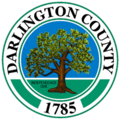2010 census
At the 2010 census, there were 68,681 people, 26,531 households, and 18,552 families living in the county. [12] The population density was 122.4 inhabitants per square mile (47.3/km2). There were 30,297 housing units at an average density of 54.0 per square mile (20.8/km2). [13] The racial makeup of the county was 55.9% white, 41.6% black or African American, 0.3% Asian, 0.3% American Indian, 0.9% from other races, and 1.1% from two or more races. Those of Hispanic or Latino origin made up 1.7% of the population. [12] In terms of ancestry, 9.5% were American, 7.0% were English, and 5.3% were Irish. [14]
Of the 26,531 households, 34.1% had children under the age of 18 living with them, 44.0% were married couples living together, 20.5% had a female householder with no husband present, 30.1% were non-families, and 26.0% of all households were made up of individuals. The average household size was 2.54 and the average family size was 3.04. The median age was 39.6 years. [12]
The median income for a household in the county was $38,379 and the median income for a family was $46,894. Males had a median income of $40,089 versus $29,255 for females. The per capita income for the county was $20,096. About 14.6% of families and 20.0% of the population were below the poverty line, including 30.7% of those under age 18 and 15.1% of those age 65 or over. [15]
2000 census
At the 2000 census, [16] there were 67,394 people, 25,793 households, and 18,441 families living in the county. The population density was 120 inhabitants per square mile (46/km2). There were 28,942 housing units at an average density of 52 per square mile (20/km2). The racial makeup of the county was 56.98% White, 41.70% Black or African American, 0.19% Native American, 0.21% Asian, 0.01% Pacific Islander, 0.39% from other races, and 0.52% from two or more races. 0.98% of the population were Hispanic or Latino of any race.
There were 25,793 households, out of which 32.20% had children under the age of 18 living with them, 48.30% were married couples living together, 18.70% had a female householder with no husband present, and 28.50% were non-families. 25.10% of all households were made up of individuals, and 9.20% had someone living alone who was 65 years of age or older. The average household size was 2.57 and the average family size was 3.07.
In the county, the population was spread out, with 26.30% under the age of 18, 9.00% from 18 to 24, 28.20% from 25 to 44, 24.40% from 45 to 64, and 12.10% who were 65 years of age or older. The median age was 36 years. For every 100 females, there were 89.80 males. For every 100 females age 18 and over, there were 84.60 males.
The median income for a household in the county was $31,087, and the median income for a family was $37,662. Males had a median income of $30,947 versus $20,998 for females. The per capita income for the county was $16,283. About 16.40% of families and 20.30% of the population were below the poverty line, including 26.70% of those under age 18 and 22.10% of those age 65 or over.
According to the 2000 census, Darlington County was classified as 41% urban and 59% rural. It contains the two urbanized areas of Hartsville (2000 pop. 14,907) and Darlington (12,066). The county's population is included within the Florence, SC Metropolitan Statistical Area.





